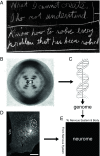Macroscale intrinsic network architecture of the hypothalamus
- PMID: 30923123
- PMCID: PMC6475403
- DOI: 10.1073/pnas.1819448116
Macroscale intrinsic network architecture of the hypothalamus
Abstract
Control of multiple life-critical physiological and behavioral functions requires the hypothalamus. Here, we provide a comprehensive description and rigorous analysis of mammalian intrahypothalamic network architecture. To achieve this at the gray matter region (macroscale) level, macroscale connection (macroconnection) data for the rat hypothalamus were extracted from the primary literature. The dataset indicated the existence of 7,982 (of 16,770 possible) intrahypothalamic macroconnections. Network analysis revealed that the intrahypothalamic macroconnection network (its macroscale subconnectome) is divided into two identical top-level subsystems (or subnetworks), each composed of two nested second-level subsystems. At the top-level, this suggests a deeply integrated network; however, regional grouping of the two second-level subsystems suggested a partial separation between control of physiological functions and behavioral functions. Furthermore, inclusion of four candidate hubs (dominant network nodes) in the second-level subsystem that is associated prominently with physiological control suggests network primacy with respect to this function. In addition, comparison of network analysis with expression of gene markers associated with inhibitory (GAD65) and excitatory (VGLUT2) neurotransmission revealed a significant positive correlation between measures of network centrality (dominance) and the inhibitory marker. We discuss these results in relation to previous understandings of hypothalamic organization and provide, and selectively interrogate, an updated hypothalamus structure-function network model to encourage future hypothesis-driven investigations of identified hypothalamic subsystems.
Keywords: hypothalamus; mammal; neuroinformatics; neurome; neuronal connections.
Conflict of interest statement
Conflict of interest statement: L.W.S. and C.B.S. were coauthors of a 2016 Commentary.
Figures







References
-
- Feynman RP, Phillips R, Gates B, Leighton R, Hutchings E. “Surely You’re Joking, Mr. Feynman!”: Adventures of a Curious Character. Reissue Ed W. W. Norton & Company; New York: 2018.
-
- Watson JD, Crick FH. Molecular structure of nucleic acids; a structure for deoxyribose nucleic acid. Nature. 1953;171:737–738. - PubMed
-
- Franklin RE, Gosling RG. Molecular configuration in sodium thymonucleate. Nature. 1953;171:740–741. - PubMed
-
- Bota M, Dong HW, Swanson LW. From gene networks to brain networks. Nat Neurosci. 2003;6:795–799. - PubMed
Publication types
MeSH terms
Grants and funding
LinkOut - more resources
Full Text Sources

